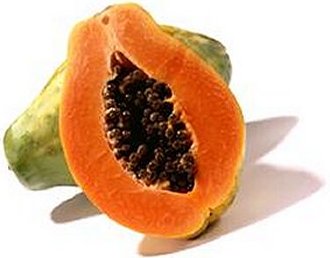Sandbox 31
From Proteopedia
(Difference between revisions)
| Line 8: | Line 8: | ||
<StructureSection load='9pap' size='500' side='right' caption='Structure of HMG-CoA reductase (PDB entry [[9pap]])' scene=''> | <StructureSection load='9pap' size='500' side='right' caption='Structure of HMG-CoA reductase (PDB entry [[9pap]])' scene=''> | ||
| - | + | ==Introduction== | |
| - | Papain is a cysteine hydrolase (EC 3.4.22.2) that is found naturally occurring in [http://en.wikipedia.org/wiki/Carica_papaya Papaya](''Carica papaya''). Papain is extracted from the latex, leaves and roots of the papaya tree. Papain is a protease commonly used for cell isolation, protein structural studies, cleaving antibodies, and various other research techniques. In addition to use in research, it is commonly used in industry to tenderize meats, remove skin from hides, and clean soft contact lenses. | + | Papain is a cysteine hydrolase (EC 3.4.22.2) that is found naturally occurring in [http://en.wikipedia.org/wiki/Carica_papaya Papaya](''Carica papaya''). Papain is extracted from the latex, leaves and roots of the papaya tree. Papain is a protease commonly used for cell isolation, protein structural studies, cleaving antibodies, and various other research techniques. In addition to use in research, it is commonly used in industry to tenderize meats, remove skin from hides, and clean soft contact lenses. |
| - | + | [[Image:papayas.jpg]] | |
| + | |||
| - | + | ==History== | |
| - | ' | + | Papain was first explorer back in 1873 by G.C. Roy, who studied papaya juice. Later, papain was extracted and named by Wertz and Bouchut who noticed it had proteolytic properties. Papain was the second enzyme to have it's structure determined by x-ray crystallography. Extensive research has be done on the structure and activity of papain and its |
| + | |||
| + | ==Structure== | ||
Papain is formed from a peptide that is 212 amino acids in length. It consists of 25% <scene name='Sandbox_31/Alpha_helices/4'>Alpha helices</scene> and 21% <scene name='Sandbox_31/Beta_sheet/2'>Beta Sheet</scene>. The structure also consists of three <scene name='Sandbox_31/Disulfide/3'>Disulfide bonds</scene> between <scene name='Sandbox_31/Cys_with_labels/2'>Cysteine Residues</scene>. The disulfide bonds exist between Cys 63 and Cys 22, Cys 200 and Cys 153, and Cys 56 and Cys 95. Another important residue to the structure is Cysteine 25 which has a sulfhydryl group that plays a major role in the active site activity[[http://www.sigmaaldrich.com/life-science/metabolomics/enzyme-explorer/analytical-enzymes/papain.html]]. | Papain is formed from a peptide that is 212 amino acids in length. It consists of 25% <scene name='Sandbox_31/Alpha_helices/4'>Alpha helices</scene> and 21% <scene name='Sandbox_31/Beta_sheet/2'>Beta Sheet</scene>. The structure also consists of three <scene name='Sandbox_31/Disulfide/3'>Disulfide bonds</scene> between <scene name='Sandbox_31/Cys_with_labels/2'>Cysteine Residues</scene>. The disulfide bonds exist between Cys 63 and Cys 22, Cys 200 and Cys 153, and Cys 56 and Cys 95. Another important residue to the structure is Cysteine 25 which has a sulfhydryl group that plays a major role in the active site activity[[http://www.sigmaaldrich.com/life-science/metabolomics/enzyme-explorer/analytical-enzymes/papain.html]]. | ||
| - | The <scene name='Sandbox_31/Hydrophobic_residues/2'>Hydrophobic Residues</scene> in papain are primarily located toward the inside of the enzyme or paired by hydrophobic interactions with other hydrophobic residues to exclude water. The <scene name='Sandbox_31/Charged/2'>Polar Residues</scene> are located facing the exterior, in the active site, or paired with other charged residues. The charged and polar residues are hydrophilic therefore do not orient themselves to exclude water. The charged <scene name='Sandbox_31/Termini/4'>Termini</scene> face outward due to their hydrophilic nature. | + | The <scene name='Sandbox_31/Hydrophobic_residues/2'>Hydrophobic Residues</scene> in papain are primarily located toward the inside of the enzyme or paired by hydrophobic interactions with other hydrophobic residues to exclude water. The <scene name='Sandbox_31/Charged/2'>Polar Residues</scene> are located facing the exterior, in the active site, or paired with other charged residues. The charged and polar residues are hydrophilic therefore do not orient themselves to exclude water or solvent. The charged <scene name='Sandbox_31/Termini/4'>Termini</scene> face outward due to their hydrophilic nature. |
| + | ==Active Site== | ||
| + | |||
| + | The active site of papain has a <scene name='Sandbox_31/Activesite/1'>"Catalytic Triad"</scene>including CYS 25, HIS 159, and ASN 175. | ||
| + | |||
| + | ==Inhibitor== | ||
| + | |||
| + | There are many inhibitors of cysteine proteases like papain, including antipain, cystatin, | ||
<scene name='Sandbox_31/1popligand_contacts/1'>TextToBeDisplayed</scene> | <scene name='Sandbox_31/1popligand_contacts/1'>TextToBeDisplayed</scene> | ||
| - | [[Image:papayas.jpg]] | ||
</StructureSection> | </StructureSection> | ||
| + | |||
| + | ==References== | ||
| + | http://dailyfitnessmagz.com/2011/03/papayas-nutrition-facts/ | ||
| + | http://www.sigmaaldrich.com/life-science/metabolomics/enzyme-explorer/analytical-enzymes/papain.html | ||
| + | http://peds.oxfordjournals.org/content/7/1/75.abstract | ||
| + | http://www.pdb.org/pdb/explore/remediatedSequence.do?structureId=9PAP | ||
Revision as of 21:52, 13 November 2011
>
| Please do NOT make changes to this Sandbox. Sandboxes 30-60 are reserved for use by Biochemistry 410 & 412 at Messiah College taught by Dr. Hannah Tims during Fall 2012 and Spring 2013. |
Papain (PDB ID #: 9pap)
| |||||||||||
References
http://dailyfitnessmagz.com/2011/03/papayas-nutrition-facts/ http://www.sigmaaldrich.com/life-science/metabolomics/enzyme-explorer/analytical-enzymes/papain.html http://peds.oxfordjournals.org/content/7/1/75.abstract http://www.pdb.org/pdb/explore/remediatedSequence.do?structureId=9PAP

